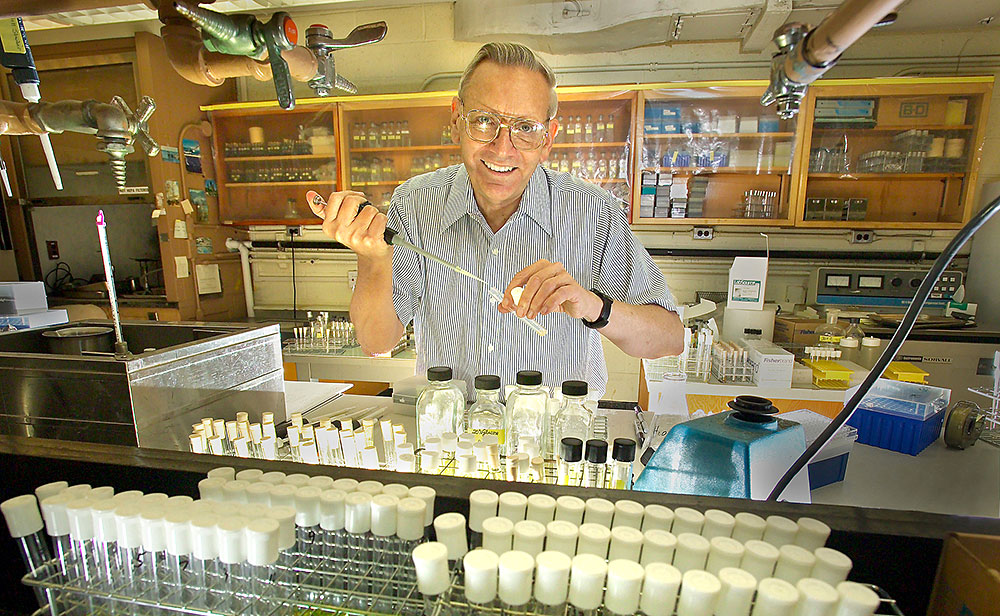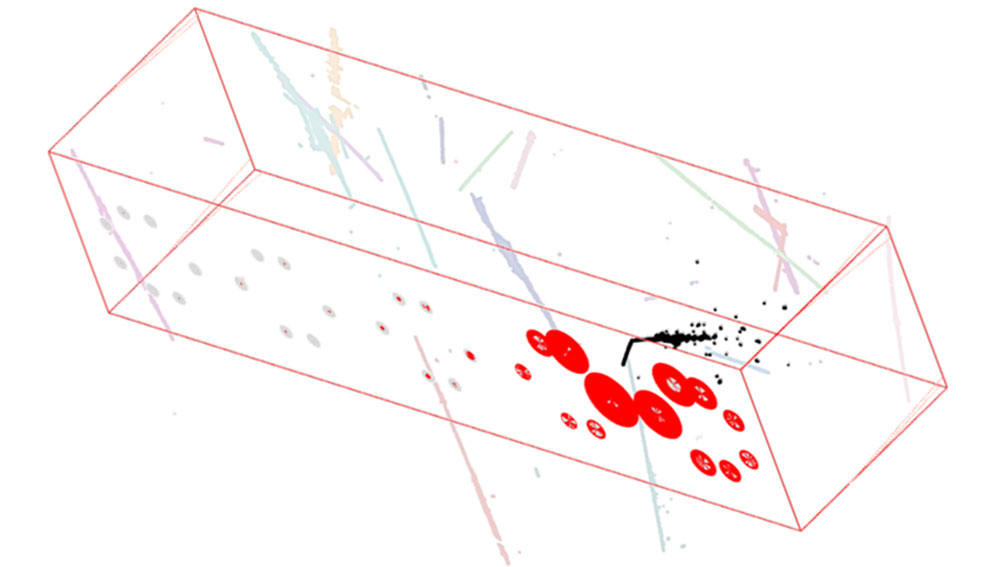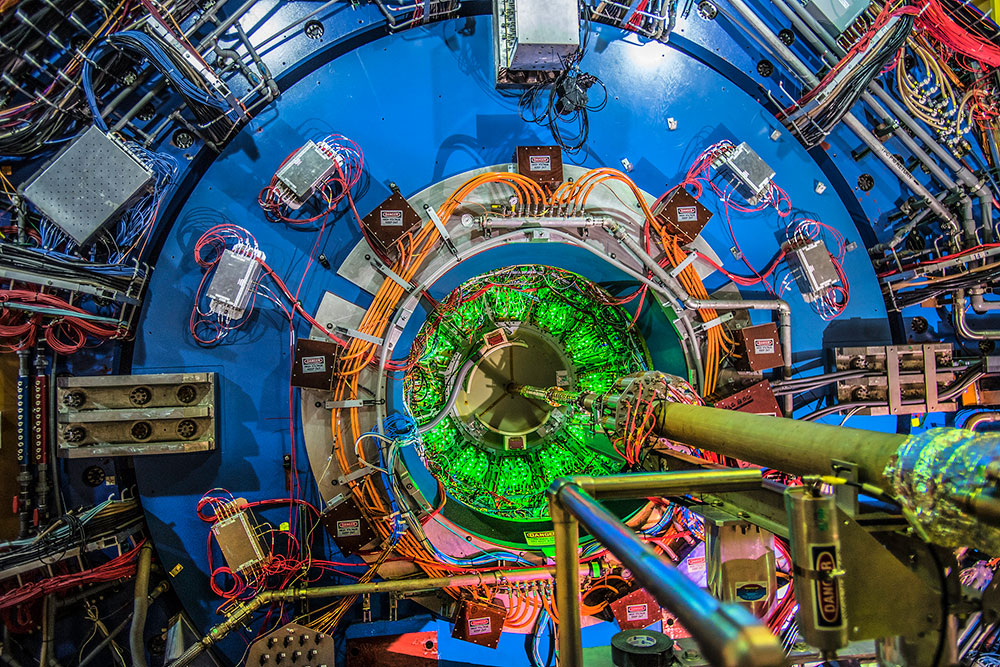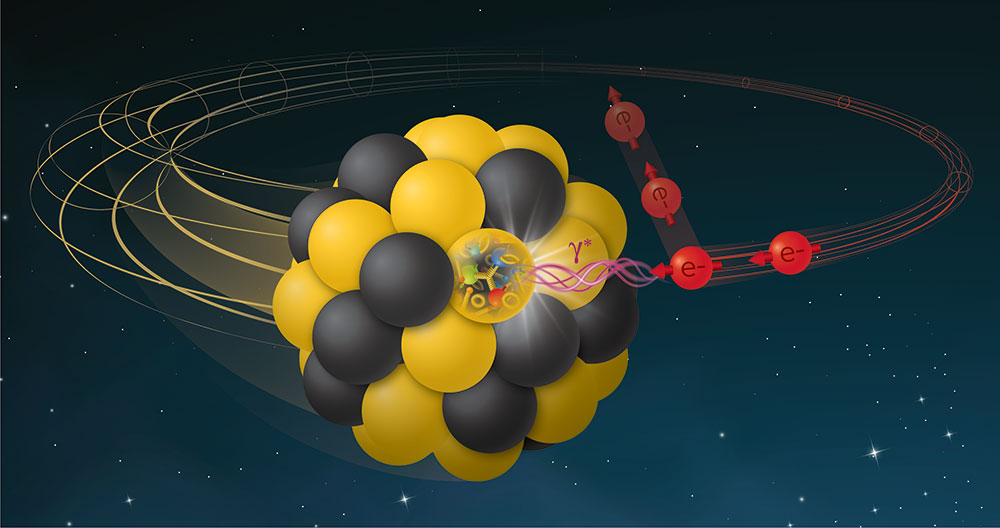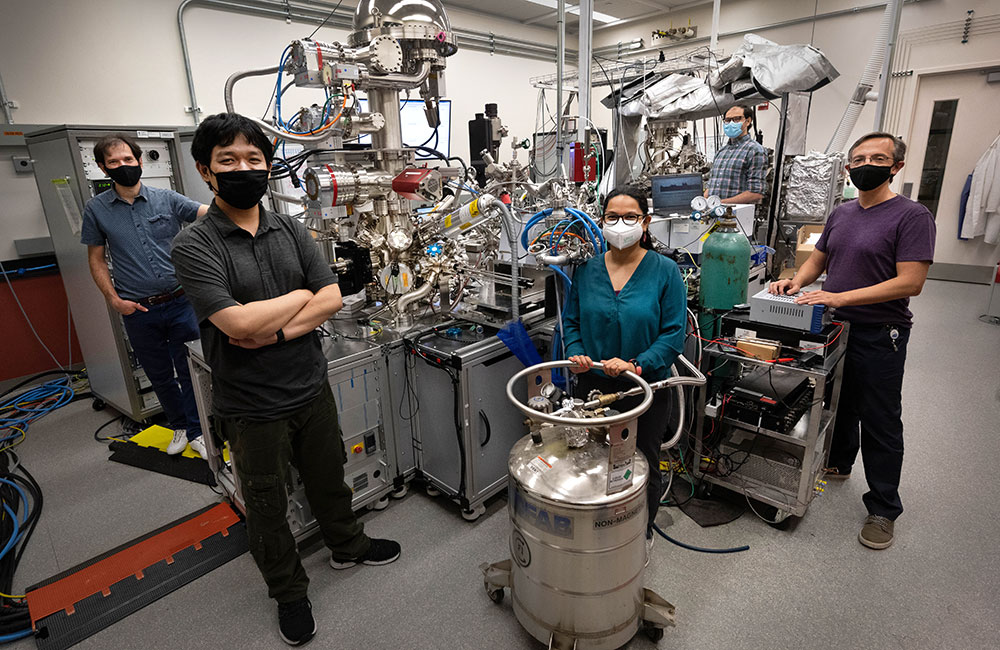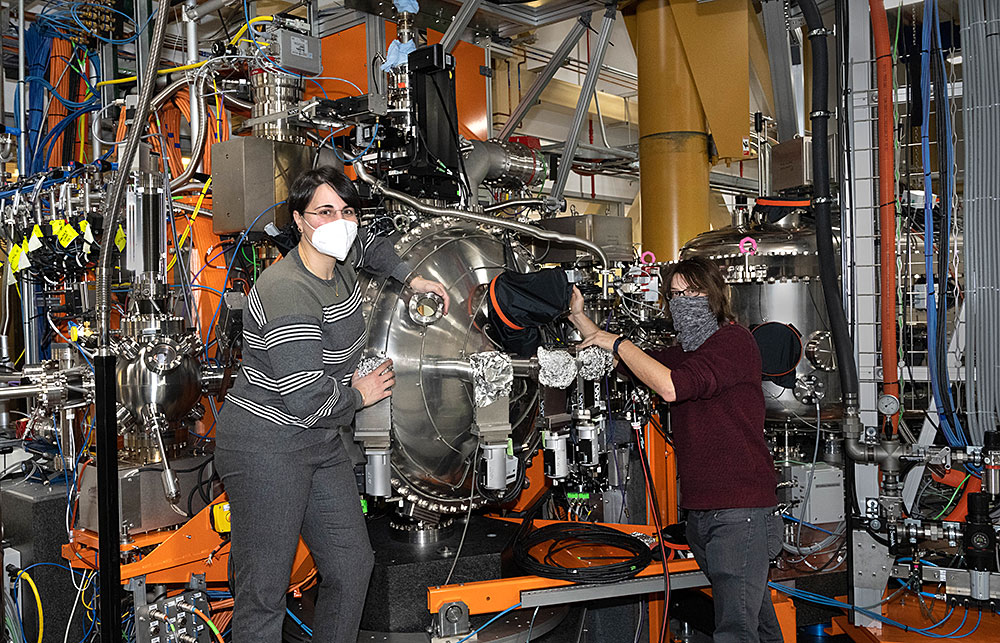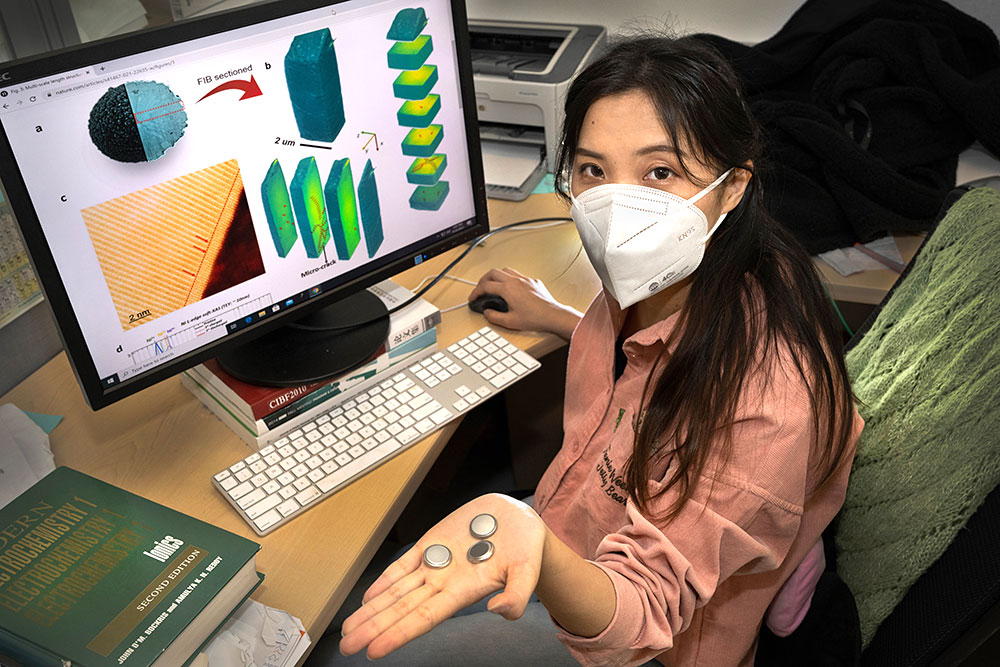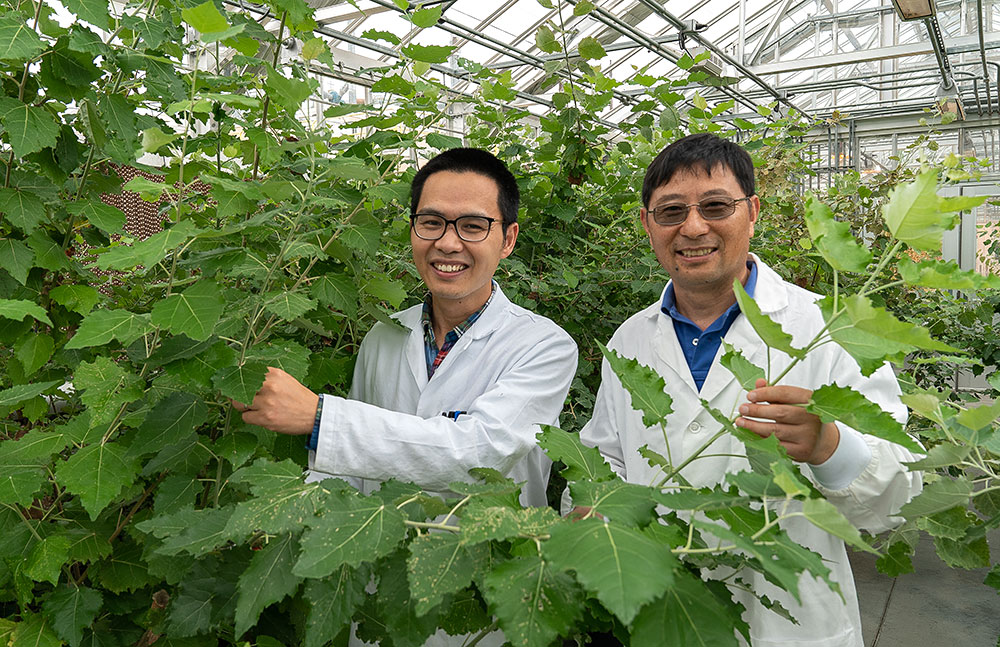Top-10 Areas of Amazing Science at Brookhaven Lab in 2021
Annual roundup of research hits showcases wide-ranging impacts on science and society
December 29, 2021
By Karen McNulty Walsh and Stephanie Kossman

Research at the U.S. Department of Energy’s (DOE) Brookhaven National Laboratory spans scales from the cosmic to subatomic, advancing our understanding of the world around and within us. Looking for discoveries that spark transformational technologies? We’ve got those too! Here’s our 2021 recap of important discoveries and most-read stories in 10 areas of amazing science at Brookhaven Lab.
Basic research battles COVID-19
The rollout of lifesaving COVID-19 vaccines tops our list of 2021 science breakthroughs, with Brookhaven’s “T7 gene-expression” system playing a crucial role. Both Pfizer and Moderna use genetic elements discovered by Brookhaven biologists more than 40 years ago to crank out “mRNA,” the critical ingredient for hundreds of millions of doses.
Using newer tools, scientists at Brookhaven’s Laboratory for BioMolecular Structure captured snapshots of the virus’s “envelope” protein bound to a human lung-cell protein. The atomic-level structures hint at how the virus wreaks havoc on the lungs—and identifies targets for designing drugs to block the devastating effects.
Another research team, including a scientist from the Center for Functional Nanomaterials at Brookhaven, developed a detailed mathematical model to understand and predict how the virus spreads. The model shows that variations in people’s social behavior, not herd immunity, drove the suppression and reemergence of COVID waves early in the pandemic. A newer study shows that random changes in social activity continue to cause transient pockets of collective immunity to wane, leading to long plateaus and possibly new waves of infection.
Members of Brookhaven’s Computational Science Initiative also continued their efforts using machine learning, artificial intelligence, and other computational tools to screen for drugs that might inhibit COVID-19. And with two other national labs, they joined the Accelerating Therapeutics for Opportunities in Medicine (ATOM) consortium, with the goal of using these tools to shorten the drug discovery timeline for other diseases, including cancer.
Read more about Brookhaven’s COVID-19 research.
Explorations of particle peculiarities
Physicists at Brookhaven are heavily involved in two major experiments that reported results from explorations of particle anomalies this year. First, the new “Muon g-2” experiment at Fermi National Accelerator Laboratory confirmed a quirky behavior of muons initially observed in a Brookhaven experiment 20 years ago. This persistent discrepancy between the combined experimental results and the theoretical predictions of muons’ behavior suggests that muons may be interacting with yet-to-be-discovered particles.
Scientists searching for a new particle to explain a different physics anomaly—in the predicted “oscillations” of neutrinos—say the MicroBooNE experiment, also at Fermilab, shows no evidence of a fourth “sterile” neutrino variety to add to the three known types. But the neutrino-tracking software/signal processing and detector technologies developed in large part by Brookhaven scientists will be key to future neutrino experiments, notably the Deep Underground Neutrino Experiment (DUNE).
Collisions create matter… and turbulence
Scientists tracking particle collisions using the STAR detector at the Relativistic Heavy Ion Collider (RHIC) created particles of matter and antimatter from light. It’s an illustration of Einstein’s famous E=mc2 equation. The results confirm a prediction made more than 80 years ago that such collisions of light particles surrounding accelerated ions could generate matter.
STAR physicists also detected tantalizing signs of “turbulence” in RHIC collision data gathered at different energies. These fluctuations may indicate a change in the way nuclear matter transforms from nucleons (protons and neutrons) to a soup of those particles’ inner building blocks, quarks and gluons.
Even as collisions continue, assembly of a new RHIC detector named sPHENIX made enormous progress this year. See updated photos and a time-lapse video.
Electron-Ion Collider project achieves major milestone
The plan to transform RHIC into the Electron-Ion Collider (EIC) received “Critical Decision 1” approval from DOE. This marks the next phase of translating the plans for the EIC into a state-of-the-art research facility that will open a new frontier in nuclear physics. Brookhaven project staff, physicists, and engineers are working with counterparts at Thomas Jefferson National Accelerator Facility and collaborators around the world to design the accelerator components while members of the EIC User Group lay out plans for possible detectors.
Nanoscience discoveries with big commercial potential
Scientists at the Lab’s Center for Functional Nanomaterials (CFN) made two discoveries related to making materials with possible commercial applications. One is a method for making extreme ultraviolet-sensitive photoresist “masks” by infusing existing organic materials with inorganic elements. The method could allow for etching smaller-scale features onto computer chips to increase their speed and efficiency.
Another group of scientists from the CFN and the National Synchrotron Light Source II (NSLS-II) used a range of methods, including x-ray studies, to discover how modifying an inexpensive commercially available porous material could trap noble gases within its nanoscale pores. If successful, the modified material could potentially capture rare noble gases such as krypton and xenon for use in specialized lighting, or to remove dangerous gases like radon from basements.
The search for error-free qubits
Brookhaven scientists are among those searching for materials that can reliably encode and store quantum information—an essential step toward developing quantum computers. Superconductors—materials in which pairs of electrons carry electrical current with no resistance—are promising candidates because they’re protected from certain kinds of interference.
In one study aimed at understanding these challenging materials, Brookhaven scientists mapped the magnetic and electronic properties of an exotic “topological” superconductor containing iron, tellurium, and selenium. Using neutron scattering at Oak Ridge National Laboratory and tools at Brookhaven’s Center for Functional Nanomaterials (CFN) and within the Lab’s Condensed Matter and Materials Science Department, they zeroed in on how changes in local chemical composition affected the material’s properties.
Another team including scientists at the National Synchrotron Light Source II (NSLS-II) and the CFN explored why a superconducting material made of niobium metal sometimes loses quantum information. They identified atomic-level structural and surface chemistry defects that might explain the loss. Both studies offer clues that could guide the design of reliable superconducting quantum information bits, or qubits.
Magnetic materials can also exhibit quantum effects that can be used in the design of next-generation electronics. For example, researchers at NSLS-II discovered that the thickness of magnetic materials can act as a “knob” for fine-tuning spin dynamics, a property of electrons that can be harnessed for transmitting information more efficiently. This study offers new insight toward the development of smaller, more energy-efficient electronic devices.
Also this year, a first-of-its-kind tool for automatically synthesizing quantum materials entered the commissioning phase at CFN. The Quantum Material Press (QPress) can synthesize, process, and characterize materials made of stacked two-dimensional sheets—and should help accelerate the discovery of new materials for applications in quantum information science.
Discoveries for building better batteries
In two separate studies aimed at improving energy storage for uses such as electric vehicles, scientists in Brookhaven’s Chemistry Division took a closer look at batteries with lithium-metal anodes. Compared to commonly-used lithium-ion batteries that use graphite anodes, batteries with lithium-metal anodes offer higher voltage and capacity. One study mapped performance variations of lithium-metal batteries across thousands of points, identifying their primary cause of failure. The second study identified new details of the reaction mechanism that takes place in these batteries, settling a decades-long debate.
Brookhaven scientists also continued researching lithium-ion batteries, searching for ways to improve performance via enhanced cathode materials. One team successfully isolated an elusive cathode material property, called a valence gradient effect, and reported how this property can be used to prevent cathode cracking and improve stability.
Focusing on whole battery systems, a team of interdisciplinary scientists at Brookhaven studied water-based batteries, which are inexpensive, abundant, and nontoxic. The team identified the primary reaction mechanism in a rechargeable, water-based battery made from zinc and manganese oxide. The study provides new insight for developing grid-scale energy storage.
All of these studies took place in part at the National Synchrotron Light Source II (NSLS-II) in collaboration with scientists there, and some included scientists and tools at the Center for Functional Nanomaterials.
To speed up such experiments (on batteries and other materials), scientists at NSLS-II have developed new ways to make experiments “smart.” These autonomous experiments use robots guided by machine learning and other artificial intelligence algorithms to optimize sample placement and data collection. They’ve also developed remote experimentation that allows researchers to control the instrumentation from afar. Together these approaches can give more researchers around the world access to NSLS-II’s unique capabilities—even in a time of COVID-19 restrictions.
Connecting clouds, climate, weather, and air quality
Atmospheric scientists tracking particles in Earth’s atmosphere published two major studies with implications for improving weather forecasts and understanding climate change. One revealed how tiny aerosol particles that seed the formation of clouds can form over the open ocean when individual atoms of trace gases react with sunlight. Another provided definitive evidence that shattering drizzle droplets drive explosive “ice multiplication” events in supercooled clouds. Among other impacts, these studies will improve scientists’ ability to represent clouds in climate models and predict major snowfall events.
To explore the connections between weather, climate, and atmospheric aerosols—including industrial pollutants and natural sources such as sea spray—Brookhaven is now leading a major field campaign in and around Houston, Texas. One major question driving the study in this coastal urban environment: Does pollution make thunderstorms worse?
In addition to these large-scale studies, Brookhaven scientists completed the first deployment of the Lab’s mobile observatory, a pickup truck equipped with a custom suite of atmospheric sampling instruments. Scientists are using the mobile observatory to monitor and understand environmental processes found in urban areas, scaling down to single city blocks. This data on “urban microclimates” will help scientists identify vulnerable areas and evaluate mitigation strategies for coping with local weather conditions and longer-term climate impacts.
Enzymes and catalysts for greener chemistry
Biologists and chemists at Brookhaven have uncovered potential keys to greener chemistry in a string of successful studies this year.
Plant biochemists in the Biology Department identified a sterol that plays a major role in the accumulation of oil in seeds, the plants’ normal oil-storage reservoir, as well as in stems and leaves. Oil-rich stems and leaves could be more easily harvested for producing biofuels. They also identified an enzyme that drives the production of p-hydroxybenzoic acid, a component of plant cell walls that could be used as a feedstock for making a wide range of industrial chemicals. And they found a way to dismantle a biochemical “roadblock” to producing a specialty fatty acid in plants. These studies suggest strategies for engineering plants to produce products that could replace petrochemicals, or to tailor plant biomass for improved bioenergy production and other applications.
Chemistry Division scientists discovered the mechanistic details of two catalysts that could help convert potent greenhouse gases into useful products: one that transforms carbon dioxide into ethanol and another that converts methane to methanol. Both ethanol and methanol can be used directly as fuels or as building blocks for making a wide range of industrial chemicals.
Opening doors to new scientists

Brookhaven is well-known for conducting discovery science and developing transformative technologies—and also for inspiring next-generation science, technology, engineering, and mathematics (STEM) professionals. In 2021, the Lab’s Office of Educational Programs (OEP) made significant strides in creating opportunities for underrepresented groups in STEM.
OEP and Brookhaven Lab’s research facilities have established a new partnership with Howard University, one of the largest Historically Black Colleges and Universities (HBCUs) and one of the top producers of physics doctorate degrees awarded to African Americans. In addition to bringing Howard students to Brookhaven for science internships, the partnership fosters faculty research and creates mutual benefits for both institutions—a model OEP hopes to replicate with additional universities in the future.
OEP also joined a collaboration that is building a community for emerging STEM professors from underrepresented minority groups. A joint effort between four Long Island institutions, the program offers training, resources, teaching opportunities, and community support.
Also this summer, the Co-Design Center for Quantum Advantage (C2QA), a national quantum information science research center led by Brookhaven Lab, held its first quantum summer school, offering students from all educational backgrounds the chance to enter an exciting and emerging research area. Half of the school’s first cohort were women and nearly 90 percent were underrepresented minorities.
Brookhaven Lab was also among 11 institutions that received new funding from DOE to broaden and diversify the nuclear and particle physics research communities. Brookhaven’s portion of the $2.85 million award funds a two-year nuclear physics fellowship, organized in collaboration with several Minority Serving Institutions, that aims to place underrepresented undergraduate students on a path to graduate school in nuclear physics, thus increasing the pool of scientific excellence in the nation. Brookhaven Lab is also coordinating with the University of Houston on an undergraduate program for minority physics students, which was funded by the same DOE award.
The research at Brookhaven Lab is funded primarily by the DOE Office of Science. CFN, NSLS-II and RHIC are DOE Office of Science user facilities.
Brookhaven National Laboratory is supported by the Office of Science of the U.S. Department of Energy. The Office of Science is the single largest supporter of basic research in the physical sciences in the United States and is working to address some of the most pressing challenges of our time. For more information, visit science.energy.gov.
Follow @BrookhavenLab on Twitter or find us on Facebook.
2021-19266 | INT/EXT | Newsroom




